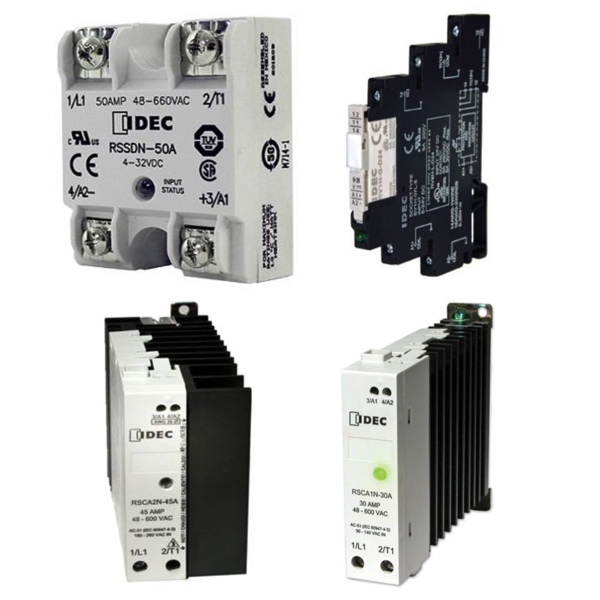IDEC Solid State Relays

Solid state relays have no moving parts like electromechanical relays, but utilize electrical components and optical properties of solid state semi-conductors to perform IO switching functions and isolation. They are designed for applications that require high switching speed without arcing or contact noise. They are highly resistant to vibration and shock and are unaffected by the presence of dust, gases or other contaminants. Solid state relays are used in heating control applications for a compressor’s soft-start, fan, blower, heater and valve control. They are used in lighting applications for dimming and for their ability to operate silently and switch quickly. Because of their resistance to shock and vibration and non-arcing, motion control applications such as lifts, hoists conveyor systems and elevators are the perfect fit for solid state relays.
IDEC RSC solid state relays are designed with a built-in heat sink to dissipate heat away from main switching components. The heat-sink, along with an epoxy-free design, eliminates the need to de-rate the relays and increases the life expectancy. The compact units for DIN Rail or panel mounting are ideal for small spaces and feature an LED status indicator.
More Information about IDEC Solid State Relays
IDEC RSS solid state relays allow switching of the most demanding loads. They are highly resistant to inrush and are ideals for lights and heaters. The “hockey puck” style is available with either DC or AC inputs and output current ratings up to 90 A. All models feature zero-voltage turn-on, to reduce inrush current and a dual SCR switch for enhanced reliability and excellent heat dissipation properties.
Relays: Electromechanical vs Solid State
Electromechanical relays (EMR)
Electromechanical relays (EMR) use physical moving parts to achieve the desired functionality. These moving parts include the contacts that switch between the normally open and normally closed stationary contacts in the relay. This movement is made possible by an electromagnet. When power is applied to this magnet, it will act on the movable contact causing the relay to switch. In an EMR, it is common to hear the switching sound that is represented as a “clicking” noise. This audible noise can be helpful when determining the functionality of the relay.
Solid-state relays (SSR)
Solid-state relays (SSR) use a low power, electrical signal to generate an optical semiconductor signal that will transmit and energize an output signal. When this is activated, the input optical signal will act as the switch, allowing a higher voltage signal to pass through the relays output components. The internal circuitry of a SSR is far more complex than an EMR, but there are no physical moving parts.

